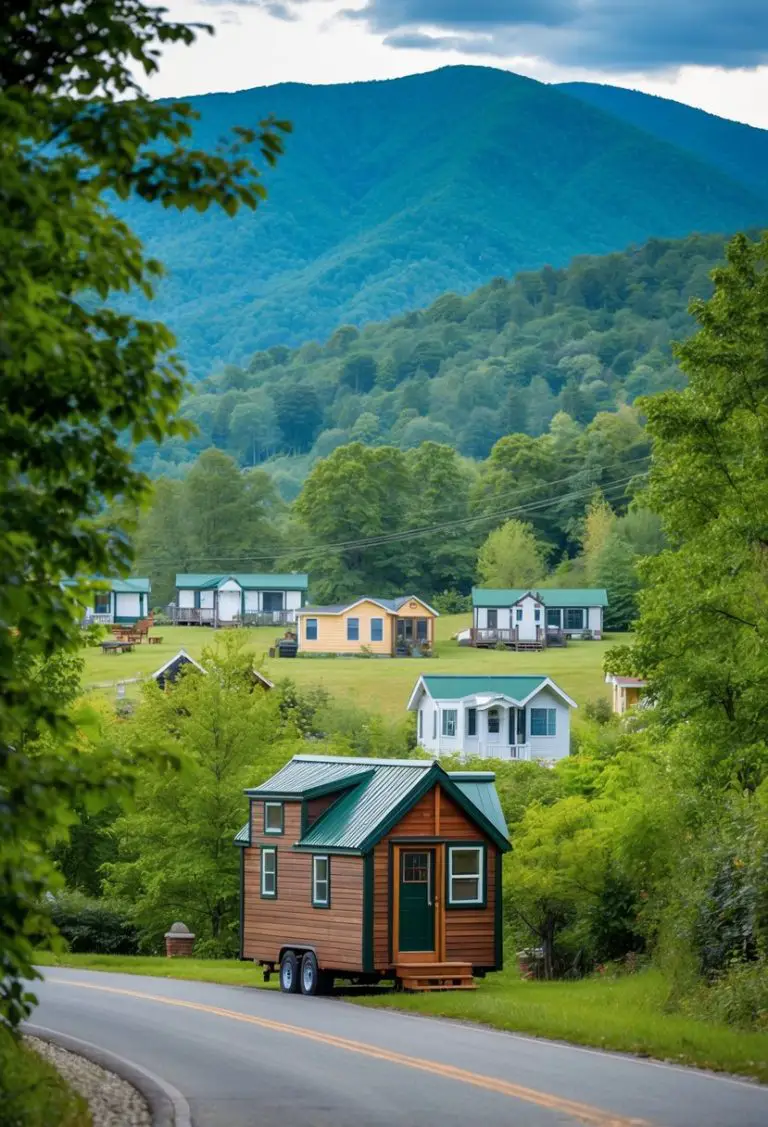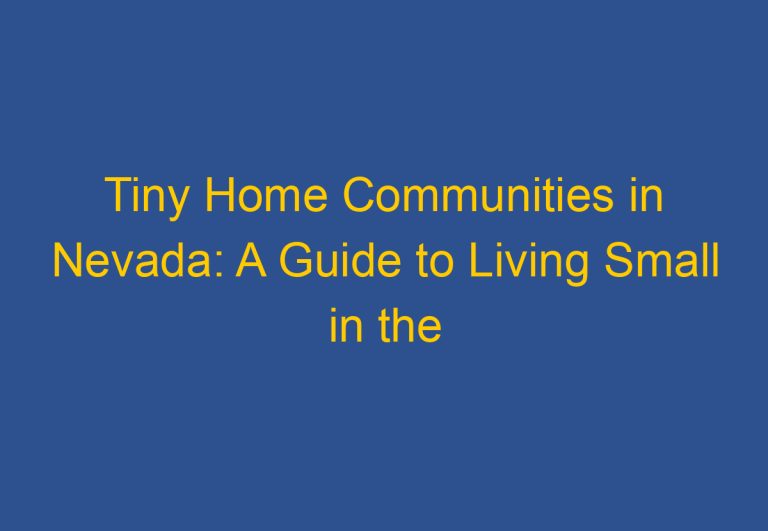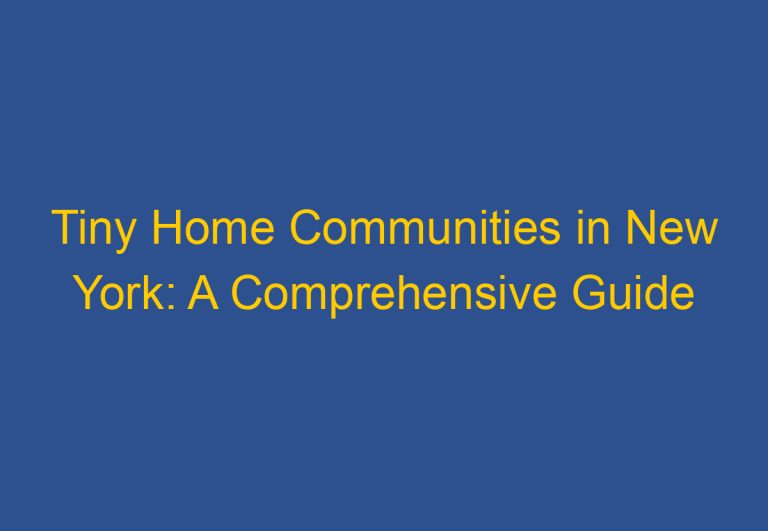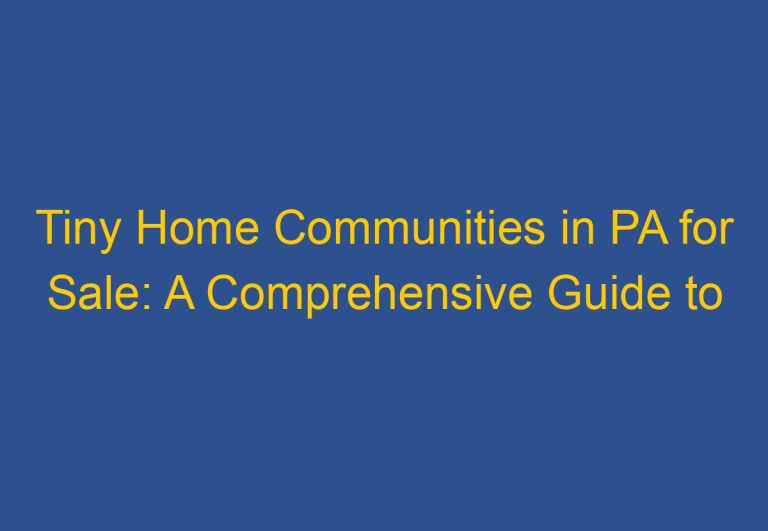Tiny Home Communities in Europe: A Growing Trend in Sustainable Living
Tiny homes have become increasingly popular in Europe in recent years, as people seek to downsize their living spaces and reduce their environmental footprint. This has led to the emergence of tiny home communities throughout the continent, where like-minded individuals can come together to live in a more sustainable and minimalist way.
These communities can take many forms, from small clusters of tiny homes in rural areas to larger developments in urban centers. Some are designed for permanent living, while others are geared towards vacation or temporary stays. Regardless of their size or purpose, these communities offer a unique opportunity for individuals to connect with others who share their values and lifestyle.
The tiny house movement has gained momentum in Europe in recent years, with many countries embracing the concept of small, sustainable living spaces. While there are still challenges to overcome, such as navigating local zoning laws and building codes, the growing popularity of tiny homes suggests that they are here to stay. As more communities continue to emerge, it will be interesting to see how this movement evolves and shapes the future of housing in Europe.
The Rise of Tiny Home Communities in Europe
In recent years, there has been a cultural shift towards minimalism in Europe, with many people opting for a simpler and more sustainable lifestyle. This has led to the rise of tiny home communities across the continent, as more and more people look for ways to downsize and live more sustainably.
Cultural Shift Towards Minimalism
The rise of tiny home communities in Europe can be attributed to a cultural shift towards minimalism. People are starting to realize that they don’t need a lot of space or possessions to be happy, and are instead choosing to focus on experiences and relationships. This has led to a growing interest in tiny homes, which offer a simple and affordable way to live.
Environmental and Sustainability Benefits
Tiny homes are also becoming increasingly popular due to their environmental and sustainability benefits. They use less energy and resources than traditional homes, and can be designed to be off-grid, reducing reliance on fossil fuels. Additionally, tiny home communities often promote sustainable living practices, such as composting and gardening, further reducing their environmental impact.
Legal Framework and Building Codes
One of the biggest challenges facing the tiny home movement in Europe is navigating the legal framework and building codes. Many countries have strict zoning laws and building codes that make it difficult to build and live in tiny homes. However, there are some countries that have embraced the tiny home movement and have created legal frameworks to support it. For example, in the Netherlands, there are several tiny home communities that have been established with the support of local governments.
Overall, the rise of tiny home communities in Europe can be attributed to a cultural shift towards minimalism, as well as the environmental and sustainability benefits of tiny homes. While navigating the legal framework and building codes can be challenging, there are signs that more and more countries are starting to embrace the tiny home movement and create legal frameworks to support it.
Design and Construction of European Tiny Homes
Innovative Use of Space and Light
When it comes to designing tiny homes in Europe, there is a strong focus on maximizing space and light. European tiny homes often feature innovative solutions for storage, such as hidden compartments and fold-out furniture. Additionally, large windows and skylights are commonly used to bring in natural light and create a sense of openness.
Materials and Eco-Friendly Features
The materials used in European tiny homes vary depending on the region and climate. However, many builders prioritize eco-friendly and sustainable options, such as locally-sourced wood and recycled materials. Insulation and ventilation systems are also important considerations for energy efficiency and comfort.
Adapting to Diverse European Climates
Europe’s diverse climates require tiny home builders to adapt their designs to suit different regions. For example, homes in colder climates may require thicker insulation and more efficient heating systems, while those in warmer regions may prioritize natural ventilation and shading solutions.
Overall, European tiny homes showcase a range of design and construction techniques that prioritize functionality, comfort, and sustainability. From innovative use of space and light to eco-friendly materials and climate-specific adaptations, tiny home builders in Europe are pushing the boundaries of small-space living.
Living in a Tiny Home Community
Living in a tiny home community in Europe is a unique experience that offers a range of benefits and challenges. In this section, we will explore the community life and shared amenities of tiny home communities and the challenges and rewards of tiny living.
Community Life and Shared Amenities
One of the most significant benefits of living in a tiny home community is the sense of community and shared amenities. Residents of tiny home communities often form close-knit communities, where they can share resources and support each other. Many communities have shared spaces, such as gardens, community centers, and workshops, where residents can socialize, work on projects, and host events. This communal lifestyle fosters a sense of belonging and can be incredibly rewarding for those who crave a sense of community.
Challenges and Rewards of Tiny Living
Living in a tiny home community also comes with its fair share of challenges and rewards. One of the primary challenges is the limited storage space, which requires residents to adopt a minimalistic lifestyle and downsize their possessions. However, this can also be a rewarding experience, as it forces residents to prioritize what is essential and live a simpler, more intentional life.
Another challenge of tiny living is the cost of building and maintaining a tiny home. While tiny homes are often less expensive than traditional homes, the costs of building, utilities, and maintenance can add up quickly. However, many residents of tiny home communities find that the lower utility bills and reduced maintenance costs offset these expenses.
In conclusion, living in a tiny home community in Europe offers a unique lifestyle that is both rewarding and challenging. The sense of community and shared amenities can be incredibly fulfilling, while the limited storage space and costs of building and maintenance require residents to adopt a minimalistic lifestyle and prioritize their needs.
Comparing Tiny Home Communities Across Europe
Regional Variations in Tiny House Communities
Tiny home communities have become increasingly popular across Europe, with different regions offering unique variations in terms of design, cost, and regulations. In Scotland, for example, there are several communities that offer affordable and sustainable living solutions. The Scottish government has also introduced various policies to support the growth of tiny home communities, such as the Scottish Land Fund and the Rural Housing Fund.
Germany is another country that has seen a rise in tiny home communities. In Berlin, for instance, there are several communities that offer affordable and eco-friendly living solutions. These communities often feature shared spaces and amenities, such as gardens, workshops, and communal kitchens.
In France, tiny home communities are often designed with a focus on sustainability and eco-friendliness. Many of these communities use renewable energy sources, such as solar panels and wind turbines, and feature green roofs and rainwater harvesting systems.
Sweden has also seen a rise in tiny home communities, with many of these communities focused on providing affordable housing solutions for young adults and students. These communities often feature shared spaces and amenities, such as laundry rooms, bike storage, and communal gardens.
Case Studies: Success Stories and Lessons Learned
One successful example of a tiny home community is the “Lillevilla” community in the Netherlands. This community features 25 tiny homes, each with its own unique design. The community also features shared spaces and amenities, such as a communal garden, a playground, and a workshop.
Another successful example is the “Wohnwagon” community in Austria. This community features 12 tiny homes, each designed with a focus on sustainability and eco-friendliness. The community also features shared spaces and amenities, such as a communal kitchen, a garden, and a sauna.
Overall, tiny home communities across Europe offer a diverse range of living solutions, each with its own unique design, cost, and regulations. By studying successful case studies and regional variations, individuals can gain a better understanding of what works and what doesn’t when it comes to creating sustainable and affordable living solutions.
Frequently Asked Questions
What are the top-rated tiny home communities in Europe?
There are several top-rated tiny home communities in Europe, such as the Tiny House Village in Germany, the Tiny House Scotland in the UK, and the Tiny House Belgium community. These communities offer a unique and sustainable lifestyle with like-minded individuals. They often have shared amenities such as gardens, kitchens, and community spaces, which foster a sense of community and social interaction.
How can I find affordable tiny home communities in Europe?
Finding an affordable tiny home community in Europe can be challenging, but it is possible. Some communities offer affordable rental options, while others allow residents to purchase their tiny homes. Online searches can help locate tiny home communities in Europe, and social media can also be a helpful tool in connecting with other tiny home enthusiasts.
Are there luxury tiny home communities in Europe, and where are they located?
Yes, there are luxury tiny home communities in Europe, and they are located in various countries such as France, Spain, and Italy. These communities offer high-end amenities such as swimming pools, spas, and fitness centers. They often feature modern and stylish designs and are ideal for individuals who desire a luxurious lifestyle in a small space.
What are the regulations for living in a tiny house in European countries?
The regulations for living in a tiny house in European countries vary depending on the country and the intended use of the tiny house. In many European countries, building codes are primarily based on the classification and use of the structure. Different regulations may apply depending on the intended use of your tiny house (e.g., permanent residence, temporary accommodation, mobile dwelling). It is essential to research the specific regulations in the country where you plan to live in a tiny house.
Can I find tiny houses for sale or rent within European tiny home communities?
Yes, many European tiny home communities offer tiny houses for sale or rent. These communities provide an opportunity to live in a tiny house without the hassle of building one. Renting or purchasing a tiny house within a community can also provide access to shared amenities and a sense of community.
Which European countries are most welcoming to the tiny house movement?
Several European countries are welcoming to the tiny house movement, including Germany, France, the Netherlands, and the UK. These countries have a growing number of tiny home communities and offer supportive regulations for tiny house living. However, it is essential to research the specific regulations in each country before deciding to live in a tiny house.












